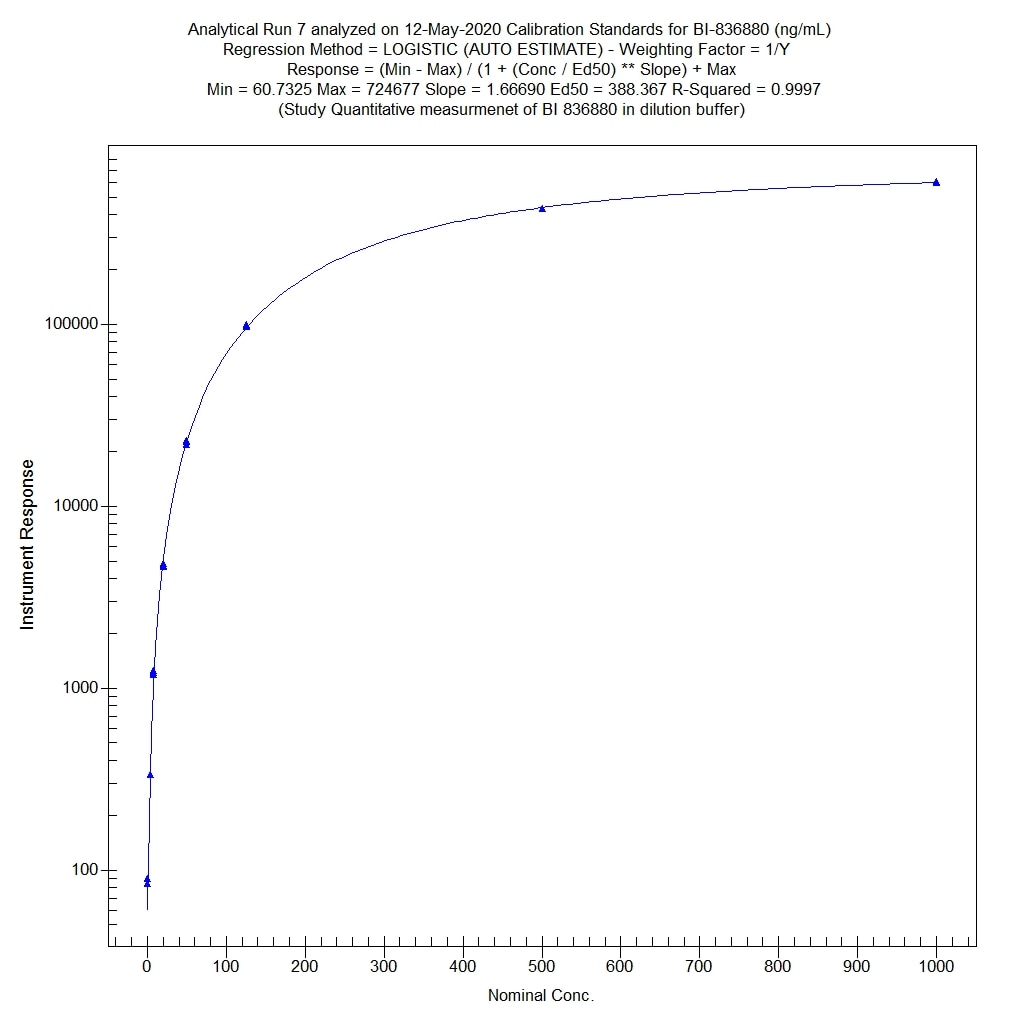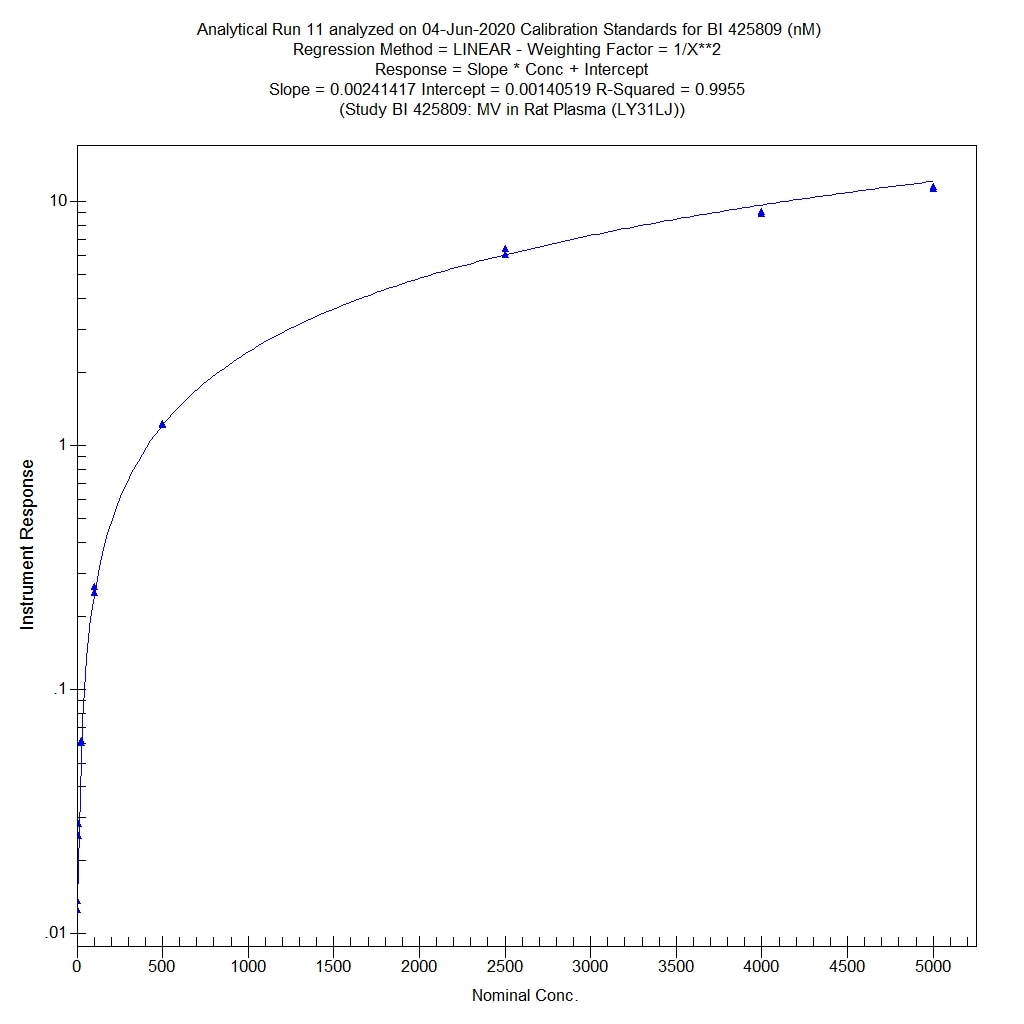Recombinant Human Angiopoietin-2, Biotinylated Protein
Recombinant Human Angiopoietin-2, Biotinylated Protein Summary
Product Specifications
Tyr19-Phe496, with a C-terminal 6-his tag
Analysis
Product Datasheets
BT623B/CF (carrier free)
Discontinued Product
BT623B
| Formulation | Lyophilized from a 0.2 μm filtered solution in MOPS, NaCl, CHAPS and PEG with BSA as a carrier protein. |
| Reconstitution | Reconstitute at 100 μg/mL in PBS. |
| Shipping | The product is shipped with polar packs. Upon receipt, store it immediately at the temperature recommended below. |
| Stability & Storage: | Use a manual defrost freezer and avoid repeated freeze-thaw cycles.
|
Reconstitution Calculator
Background: Angiopoietin-2
Angiopoietin-2 (Ang-2; also ANGPT2) is a secreted glycoprotein that plays a complex role in angiogenesis and inflammation (1, 2). Mature human Ang-2 is 478 amino acids (aa) in length. It contains one coiled-coil domain (aa 166-248) that mediates multimerization, and a C-terminal fibrinogen-like domain (aa 275-495) that mediates receptor binding. Under reducing conditions, secreted monomeric Ang-2 is 65-66 kDa in size. Under non-reducing conditions, both natural and recombinant Ang-2 form 140 kDa dimers, 200 kDa trimers, and 250-300 kDa tetramers and pentamers (3-5). Alternative splicing generates a short isoform that lacks 52 amino acids (aa) preceding the coiled-coil domain (6). Mature human Ang-2 shares 86% aa sequence identity with mouse and rat Ang-2. Ang-2 is widely expressed during development, but it is restricted postnatally to highly angiogenic tissues such as the placenta, ovaries, and uterus (3). It is particularly abundant in vascular endothelial cells (EC) where it is stored in intracellular Weibel-Palade bodies (1, 3, 7). Both Ang-2 and the related Angiopoietin-1 (Ang-1) are ligands for the receptor tyrosine kinase Tie-2 (2). While Ang-1 is a potent Tie-2 agonist, Ang-2 may act as either a Tie-2 antagonist or agonist, depending upon its state of multimerization. The higher the order of oligomer, the more effective Ang-2 becomes as a Tie-2 agonist (3, 8-11). The short isoform appears to block the binding of either Ang-1 or full-length Ang-2 to Tie-2 (5). Ang-2 functions as a pro-angiogenic factor, although it can also induce EC death and vessel regression (12, 13). Upon its release from quiescent EC, it regulates vascular remodeling by promoting EC survival, proliferation, and migration and destabilizing the interaction between EC and perivascular cells (8, 13, 14). Ang-2 is required for postnatal vascular remodeling, and it cooperates with Ang-1 during lymphatic vessel development (7, 15). It mediates the up-regulation of ICAM-1 and VCAM-1 on EC, which facilitates the adhesion of leukocytes during inflammation (16). Ang-2 is up-regulated in both the endothelium and tumor cells of several cancers as well as in ischemic tissue (17-20). Its direct interaction with Integrins promotes tumor cell invasion (21, 22). Ang-2 also promotes the neuronal differentiation and migration of subventricular zone progenitor cells (20).
- Augustin, H.G. et al. (2009) Nat. Rev. Mol. Cell Biol. 10:165.
- Murdoch, C. et al. (2007) J. Immunol. 178:7405.
- Maisonpierre, P.C. et al. (1997) Science 27:55.
- Procopio, W.N. et al. (1999) J. Biol. Chem. 274:30196.
- Kim, K-T. et al. (2005) J. Biol. Chem. 280:20126.
- Kim, I. et al. (2000) J. Biol. Chem. 275:18550.
- Gale, N.W. et al. (2002) Dev. Cell 3:411.
- Yuan, H.T. et al. (2009) Mol. Cell. Biol. 29:2011.
- Falcon, B.L. et al. (2009) Am. J. Pathol. 175:2159.
- Kim, H-Z. et al. (2009) Biochim. Biophys. Acta 1793:772.
- Kim, I. et al. (2001) Cardiovasc. Res. 49:872.
- Lobov, I.B. et al. (2002) Proc. Natl. Acad. Sci. 99:11205.
- Cao, Y. et al. (2007) Cancer Res. 67:3835.
- Nasarre, P. et al. (2009) Cancer Res. 69:1324.
- Dellinger, M. et al. (2008) Dev. Biol. 319:309.
- Fiedler, U. et al. (2006) Nat. Med. 12:235.
- Koga, K. et al. (2001) Cancer Res. 61:6248.
- Etoh, T. et al. (2001) Cancer Res. 61:2145.
- Tressel, S.L. et al. (2008) Arterioscler. Thromb. Vasc. Biol. 28:1989.
- Liu, X.S. et al. (2009) J. Biol. Chem. 284:22680.
- Hu, B. et al. (2006) Cancer Res. 66:775.
- Imanishi, Y. et al. (2007) Cancer Res. 67:4254.
Citations for Recombinant Human Angiopoietin-2, Biotinylated Protein
R&D Systems personnel manually curate a database that contains references using R&D Systems products. The data collected includes not only links to publications in PubMed, but also provides information about sample types, species, and experimental conditions.
2
Citations: Showing 1 - 2
Filter your results:
Filter by:
-
Directed evolution of an angiopoietin-2 ligand trap by somatic hypermutation and cell surface display.
Authors: Brindle, Nicholas, Sale, Julian E, Arakawa, Hiroshi, Buerstedde, Jean-Mar, Nuamchit, Teonchit, Sharma, Shikha, Steele, Kathryn
J Biol Chem, 2013-10-08;288(46):33205-12.
Species: Human
Sample Types: Whole Cells
Applications: Flow Cytometry -
Engineering a therapeutic IgG molecule to address cysteinylation, aggregation and enhance thermal stability and expression.
Authors: Buchanan A, Clementel V, Woods R, Harn N, Bowen M, Mo W, Popovic B, Bishop S, Dall'Acqua W, Minter R, Jermutus L, Bedian V
MAbs, 2013-02-14;5(2):255-62.
Species: Human
Sample Types: Protein
Applications: Functional ELISA
FAQs
No product specific FAQs exist for this product, however you may
View all Proteins and Enzyme FAQsReviews for Recombinant Human Angiopoietin-2, Biotinylated Protein
Average Rating: 5 (Based on 2 Reviews)
Have you used Recombinant Human Angiopoietin-2, Biotinylated Protein?
Submit a review and receive an Amazon gift card.
$25/€18/£15/$25CAN/¥75 Yuan/¥1250 Yen for a review with an image
$10/€7/£6/$10 CAD/¥70 Yuan/¥1110 Yen for a review without an image
Filter by:



